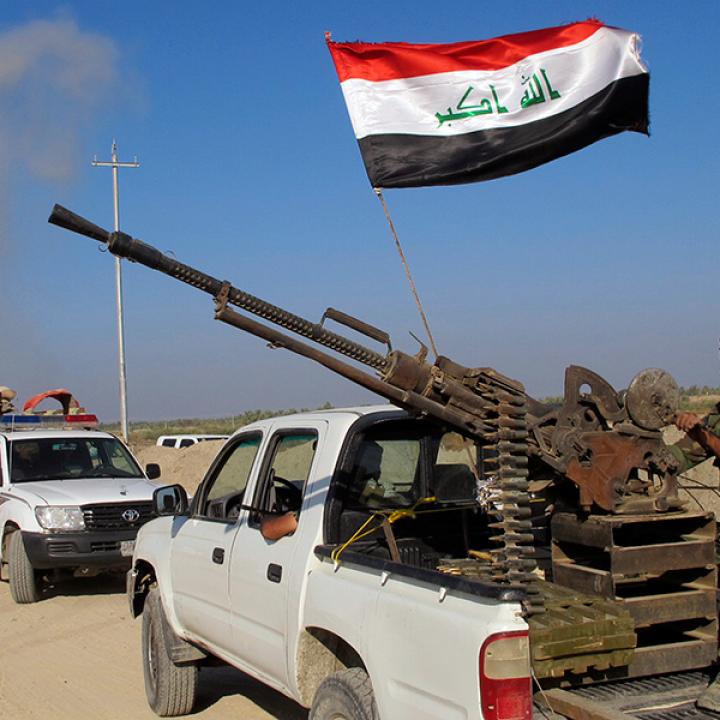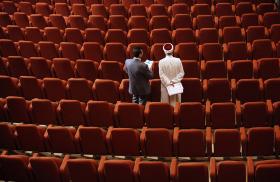
- Policy Analysis
- PolicyWatch 2408
Pushing Back ISIS: Getting the Ground Component Right

U.S. airpower, regular Iraqi troops, and local fighters constitute the model for rolling back ISIS in Anbar and Mosul.
The April 14-16 visit to Washington by Iraqi prime minister Haider al-Abadi, previewed with gusto by Vice President Joe Biden at the National Defense University on April 9, will rightly focus attention on Iraq and next steps with the Islamic State of Iraq and al-Sham (ISIS). While any Middle East-related issue has much competition for attention -- U.S.-Israel disputes, Syria, Yemen, and of course the Iran nuclear framework -- Iraq is as important an interrelated element in the Middle East mosaic as any of the others, and thus deserves the attention. As Biden indicated, ISIS has lost momentum and the coalition is gaining on it, with further offensive operations on the way. How they will be organized is crucial not only for battlefield victory but also for "day after" scenarios to keep Iraq free of terrorists and sectarian violence over the long term.
Coalition Options
Following the victory over ISIS in Tikrit, the coalition has several options open, and the media is reporting debate on whether to first use the Baghdad-Tikrit avenue of approach to tackle Anbar province, the huge Sunni Arab-populated largely desert area stretching from the west of Baghdad's suburbs all the way to the Jordan-Syria border, with much of the province under ISIS control or pressure, or to use the Tikrit-Erbil-Bayji avenue of approach to go for Mosul, ISIS's informal "capital" in Iraq.
Strong arguments can be made for either move. Anbar and Mosul were always the cockpits of ISIS's predecessor organization, al-Qaeda in Iraq (AQI). The January 2014 fall of Fallujah, almost by default after then prime minister Nouri al-Maliki pulled his forces out following an ugly incident with a local parliamentarian, signaled AQI's return to Iraq, now in ISIS's much more lethal packaging. And the June 2014 fall of Mosul, entailing the rout of tens of thousands of Iraqi government forces and the loss of two whole provinces, was an even bigger blow to Iraq. ISIS leader Abu Bakr al-Baghdadi's selection of Mosul for his "caliphate" speech last summer was also dramatically symbolic.
ISIS's loss of either of these citadels in its core territory, even more than Tikrit or the Syrian Kurdish town of Kobani, will be widely interpreted as a sign of the group's decay, possibly accelerated by a gradual drying up of foreign recruits, although that has not yet verifiably occurred. But this next offensive step deep into ISIS territory will be more complex and difficult than the recapture of Tikrit, and raises the question of whose ground troops will take the fight to the foe.
Washington's answer has been the U.S. training and equipping of a force composed of major elements of the nine Iraqi army brigades. Whenever Mosul is tackled, three Kurdish Peshmerga brigades -- with brigades containing some 2,000-5,000 troops in each, and Iraqi units typically on the low side -- will be added to the mix. Various "dependable" other Iraqi regular and Peshmerga units that have proved themselves in fighting against ISIS likely will also participate -- including, on the government side, the very effective Counter-Terrorist Force, certain U.S.-equipped tank and artillery units, national police forces, and, around Mosul, Peshmerga. Local units of Sunnis in the nascent National Guard structure probably will also participate, including tribes in Anbar and remnants of the Mosul police force in the north. Timing and target priorities will have to be settled in Washington between Abadi and President Obama, but maintaining momentum suggests new action in the coming several months, with Anbar probably the more likely next target.
Curbing Iran's Role
What is neither necessary nor desirable in the next offensive is Iranian advisory teams -- in Tikrit, these were backed with Iranian rocket artillery -- and Shiite militias long under Iran's influence. Various journalists and analysts have suggested a possible informal U.S.-Iran joint effort against ISIS, based on the involvement of U.S. airpower and Shiite militias in the Tikrit battle. But these Shiite forces on their own, even when led by the now legendary Qasem Soleimani, commander of Iran's IRGC Qods Force, could not dislodge some hundreds of ISIS fighters from Tikrit center. Rather, it was U.S. airpower, Iraqi regular troops, and other Shiite militias that finished the job in Tikrit.
The U.S. military in fact publicly stated that it would not coordinate with the Iranians or their associated militias. Vice President Biden, in his April 9 remarks, powerfully reiterated this theme. Part of the confusion then lies with the term "Shiite militias." These include the Badr Organization, Asaib Ahl al-Haqq, and Kataib Hezbollah, long supported directly by Iran, the latter two with American blood on their hands, but also the Shiite volunteers who, along with a few Sunnis, enlisted in the Popular Mobilization Committees (PMCs) summoned last summer by Shiite clerical leader Grand Ayatollah Ali al-Sistani. Unlike the Iran-supported organizations, the PMCs are to some degree under Iraqi government control. Muqtada al-Sadr's forces, once known as Jaish al-Mahdi, or the Mahdi Army, occupy an in-between position -- they have a long record of fighting the United States and Baghdad, from 2004 to 2008, but are generally independent of and somewhat suspicious of Iran.
The U.S. military is prepared to, and in Tikrit did, coordinate through the Iraqi government with Shiite militias in the PMCs, not the Iran-backed ones. The Iranian advisors and "their" militias stayed largely out of the Tikrit fight after the United States began airstrikes. Shiite and a few Sunni PMC elements continued to fight, but under Iraqi army command. Given the dearth of reliable Iraqi regular forces, and the limits on the "acceptability" of the Kurdistan Regional Government's Peshmerga troops outside Kurdish areas, the U.S.-Baghdad alliance will have to rely to various degrees on Shiite as well as Sunni Arab irregular forces. Not only is this militarily sensible, but it is wise politically. After all, the PMCs are the "child" of Grand Ayatollah Sistani. He not only recently called up these forces but has spoken out publicly in the last phase of the Tikrit battle, after the United States had intervened on the Iraqi government's request, in support of the government's actions and responsibility. This reflected an indirect Sistani endorsement -- subtle as always with him -- of the U.S. role.
Future U.S. Steps
The United States could accelerate the combat effectiveness of the Iraqi and Peshmerga brigades thrown into the fight by embedding in each of the brigades’ subordinate maneuver battalions U.S. military advisory teams, close air support coordinators, and possibly combat engineer experts to deal with mines and booby traps. Such steps could reduce the need for at least the Shiite irregulars -- Sunni irregulars are absolutely necessary in Sunni areas -- who at times have misbehaved in Sunni areas, although not to the degree seen with the Iran-backed militias. The latter, as noted, have no place in the next phase of the fight.
In sum, Tikrit was a win for the United States and Abadi, and a defeat for ISIS but also for Iran and friends. As such, it was also a victory for the nation-state system over irregular and transnational ideological forces. Not these forces, but U.S. airpower, regular Iraqi troops, and local augmenting fighters, constitute the model for defeating ISIS. That is the model the United States can and should use to roll back ISIS in Anbar and Mosul. These victories will not destroy ISIS but will significantly reduce its strength, reputation, and territory. As long as the group holds much of eastern Syria, where the United States has no reliable ground allies, ISIS will survive. And as long as it survives, the alliance's success in Iraq will remain at risk, with the question of which forces to "hold" territories taken from ISIS still outstanding.
James Jeffrey is the Philip Solondz Distinguished Visiting Fellow at The Washington Institute and former U.S. ambassador to Iraq and Turkey.



